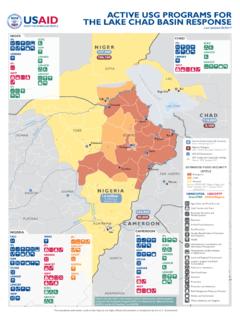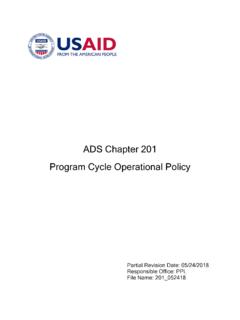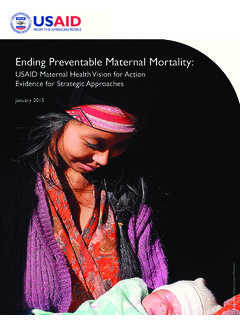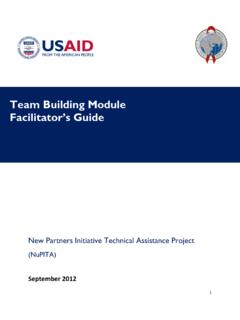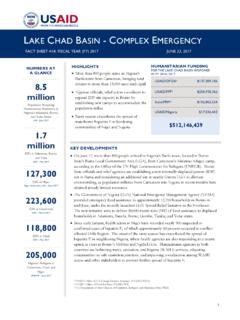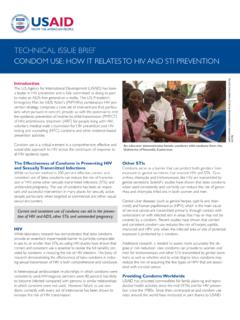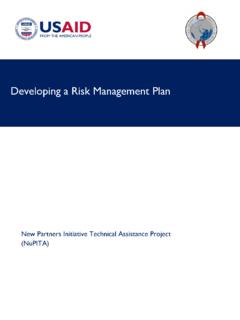Transcription of Discussion Note COMPLEXITY-AWARE MONITORING
1 PROGRAM CYCLE GUIDANCE. Discussion Note COMPLEXITY-AWARE . MONITORING . Bureau MONITORING & EVALUATION SERIES. USAID typically uses a specific approach to MONITORING , referred to as performance MONITORING . Performance MONITORING uses indicators designed to measure results that contribute to broader country strategy results frameworks or project LogFrames. Bureau Annual (or semi-annual) review of country strategy (CDCS) performance data is intended to inform high-level decision making. At the project and activity level, MONITORING is intended to inform implementation. Performance MONITORING practice involves collecting baseline data, setting targets, and comparing actual figures to targets. (For more information on USAID's approach to performance MONITORING , please see the Automated Directives System 200 series).
2 Outside the Agency, the term MONITORING . This Discussion Note is designed to prompt may be used to describe a much broader array inquiry and experimentation within USAID. of practices with roots in diverse theoretical Developed in consultation with outside perspectives. For example, MONITORING , for experts in the principles and methods other organizations, does not necessarily described and with USAID staffers who are involve results, indicators, baselines or targets. already experimenting with new M&E. methods, it is a starting point for USAID. This Discussion note outlines general principles staff wishing to experiment with methods and promising approaches for MONITORING that suit some aspects of their portfolios.
3 Complex aspects of USAID development This publication was produced for review by assistance. COMPLEXITY-AWARE MONITORING is the United States Agency for International distinct from performance MONITORING as Development. It was prepared by Heather practiced in USAID and is intended to Britt for DevTech Systems, Inc., under complement performance MONITORING when Contract No. AID-OAA-M-11-00026. The used for complex aspects of projects and views expressed in this publication do not strategies. COMPLEXITY-AWARE MONITORING may necessarily reflect the views of the United be considered normal MONITORING by some States Agency for International working in other organizations or contexts. Development or the United States Nevertheless, consideration of these principles Government.
4 And approaches may strengthen practice. JUNE 2016 / PAGE 1. WHEN TO USE COMPLEXITY-AW ARE. MONITORING . COMPLEXITY-AWARE MONITORING is appropriate for aspects of strategies or projects where cause and effect relationships are poorly understood, thereby making it difficult to identify solutions and draft detailed implementation plans in Expected results may also require Figure 2: AGREEMENT AND CERTAINTY MATRIX. refinement and revision as Source: Patton, (2011). Developmental Evaluation: strategies and projects unfold. Applying Complexity Concepts to Enhance Innovation and Use. New York: The Guildford Press, p. 94. Projects (or parts of projects) that rely heavily on adaptive management2 to steer effectively in Figure 1: AGREEMENT AND CERTAINTY MATRIX.
5 Source: Patton, (2011). Developmental Evaluation: Applying dynamic contexts, and projects that Complexity Concepts to Enhance Innovation and Use. New York: The seek to influence social change or Guildford Press, p. 94. innovate to discover solutions are likely candidates for COMPLEXITY-AWARE MONITORING . On the other hand, projects that deliver services, or roll out, replicate, or scale up tried and true programming strategies are not generally a good match for these MONITORING approaches. Two questions can help identify complex aspects of a project or strategy: What is the degree of certainty about how to solve the problem? What is the degree of agreement among stakeholders about how to solve the problem?
6 According to the Agreement and Certainty Matrix3 depicted in Figure 1, complex aspects of situations are distinguished from simple and complicated by both low certainty and low agreement. In situations of low certainty, even the experts are uncertain about the best way to achieve results. In low agreement, key stakeholders disagree about which results are desirable. Those in the Agency working with the Cynefin framework4 depicted in Figure 2, recognize complexity when diverse elements Figure 2: CYNEFIN FRAMEWORK. interact with each other in unanticipated Source: Wageningen UR, 2012. JUNE 2016 / PAGE 2. ways to create a new reality. Complex aspects of a situation cannot be known or predicted ahead of time; cause-effect relationships emerge only retrospectively.
7 Complexity responds well to probe-sense-respond management approaches, in which development practitioners experiment, gather information, and then act accordingly. The Cynefin framework contrasts complex dynamics with simple, complicated and chaotic. In simple aspects, causal dynamics are well known. The right answer is common knowledge. Best practices have been identified. In complicated aspects of a situation, cause-effect relationships are knowable with additional expertise or time and energy to understand and measure. Experts would be expected to possess the relevant knowledge, and to be able to identify effective good practices. Alternatively, piloting, testing or experimenting would serve to unveil the cause-effect relationships.
8 Chaotic aspects of a situation are ones in which there is so much turbulence that causal relations are not perceivable even after effects emerge and there is no time to investigate or figure out right answers. Those dealing with chaotic aspects must act quickly and decisively to reduce the turbulence. Projects and their environments can have some simple aspects, some complicated aspects and some complex aspects; it is more useful to identify these individually than to attempt to classify a whole situation as either one or the In general, social change and development contexts and programming tend to contain a mix of complicated and complex aspects. Thus, complexity is neither a special circumstance (such as conflict or transition), nor a blanket descriptor.
9 Furthermore, judgments about complexity are ones about relative disagreement and uncertainty. Complicated aspects of a system may evolve to demonstrate complex dynamics or complex aspects may become Also, aspects of complexity worth MONITORING may cross boundaries of projects, activities, and contracting mechanisms. Let's take the example of a vaccination project (Table 1). Aspects of the project demonstrate simple, complicated, and complex dynamics. Vaccines work by introducing a modified version of a disease agent into the body, thereby stimulating the body's immune system to build up defenses against the pathogen. If a vaccinated individual encounters the disease agent again, the immune system will be able to ward off the disease.
10 The cause and effect relationships are known and the effectiveness of vaccines is very high. Preventing common childhood diseases is generally agreed to be a worthwhile goal. Therefore, both certainty and agreement about how vaccinations work and the desirability of preventing childhood disease of the project is high. We can call this aspect of the project simple. Simple does not mean that a successful vaccination project will be easy. JUNE 2016 / PAGE 3. TABLE 1: CERTAINTY & AGREEMENT IN SIMPLE, COMPLICATED & COMPLEX ASPECTS OF. PROJECTS. Simple High certainty, high agreement Stimulating immunity through vaccines Complicated (technically) Low certainty, high agreement Delivering vaccines to remote populations through a weak health system; population values vaccines Complicated (socially) High certainty, low agreement Delivering vaccines to resistant communities through a well- resourced health system Complex Low certainty, low agreement Delivering vaccines to resistant communities through a weak health system Other aspects of the project, such as logistics, may not be simple.
